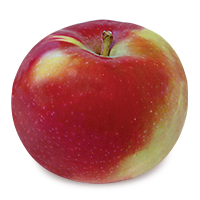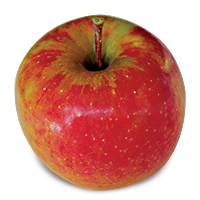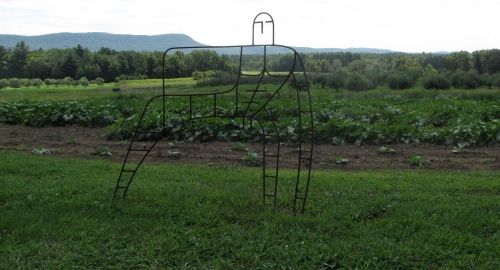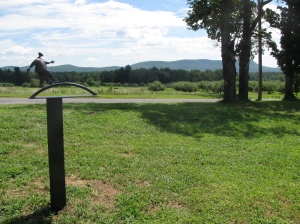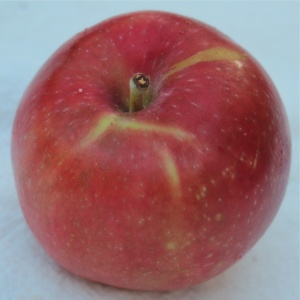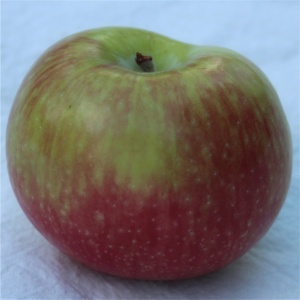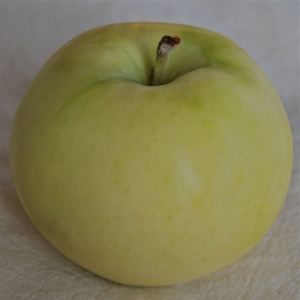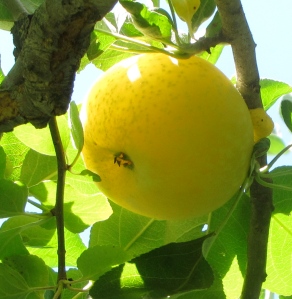
A full crop of apples will soon be ripe at Carlson Orchards, Harvard, Massachusetts, but first comes the peaches. The orchard holds its 13th Annual Peach Festival this weekend. (Bar Lois Weeks photo)
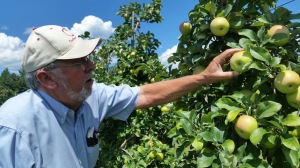
Frank Carlson inspects Honeycrisp apples, which are still developing size and color. (Bar Lois Weeks photo)
THERE IS NOTHING like a day of orchard hopping to get the juices going about the 2015 apple crop. We arrived at Carlson Orchards in Harvard, Massachusetts, around noon on a beautiful August day. Frank Carlson, who runs the orchard with his two brothers, Bruce and Bobby, had Greek salads waiting for us at a picnic table, but he had to excuse himself several times to take phone calls or fill orders for peaches. At 72, Frank is always on the move, yet in between interruptions he patiently offers a steady stream of information and observations about apples and tree fruit.
The big news of the day was about dreaded hail. A series of vicious storms had swept across much of the region the day before, and growers were now looking for news of their neighbors, comparing notes, and looking for damage.
Just a few seconds of hail can injure an apple crop, shredding the leaves and nicking the fruit. A bad storm can wipe out an entire orchard in less than a minute. Fortunately Carlson Orchards was not hit, but there were scattered reports of hail in central Massachusetts.
It has been a good spring and summer growing season so far, but there are still several critical weeks before the main harvest begins in September. The growers can only hope that they get through this period without getting hit by heavy winds, which can knock apples off the tree, or hail.
But Carlson Orchards, like most of New England’s orchards, has an outstanding crop. We drove through the orchard and stopped to inspect Ginger Gold, Honeycrisp, and Macoun trees, all loaded with developing fruit. We followed the shrill note of a red-tailed hawk and watched it soar above the orchard. The raptor is welcome here, as it helps keep down the rodent population. Every living creature wants a bite of these apples, it seems, from deer and turkeys to mice, bugs, and bacteria.
Frank points out a sun spot on one apple, the fruit’s equivalent of sunburn. There are tiny nicks from hail on just a few apples, not enough to worry about. He cuts a third apple open to reveal some discoloring inside. These are minor flaws. All things considered, it appears to be an excellent crop.
Other than the threat of hail, the big unknowns now are size and color, for which the next month’s weather will play a critical role. Timely rain in the next few weeks will help the apples size properly. Cool nights are needed to draw the apple’s sugars closer to its skin, and to develop red color.
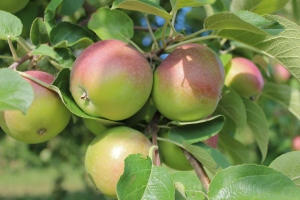
The trees are brimming with apples at Brookfield Orchards, North Brookfield, Massachusetts, above and below left. (Bar Lois Weeks photos)
It is early August, but the earliest apples have already come and gone, starting with two rare ancient apples of Russian descent, Red Astrachan and Yellow Transparent. Their age and parentage are unknown, but they are believed to go back to at least the 17th century. Both apples ripen in late July, and they are gone in a few short weeks.
Red Astrachan’s mild, tart flavor is considered especially good in sauce and pies. Yellow Transparent is sweet with a hint of tartness. Both heirlooms can satisfy a craving for fresh apples if eaten soon after they are picked, but their flesh softens almost as quickly as a blueberry or peach.
A newer short-season apple called Vista Bella was being picked in late July at Red Apple Farm in Phillipston, Massachusetts. Developed at Rutgers University in 1956 from a mix of five rare apples (July Red, Melba, Sonora, Starr, and Williams), Vista Bella was not released commercially until 1974. Its flavor is mild, with a hint of raspberry.
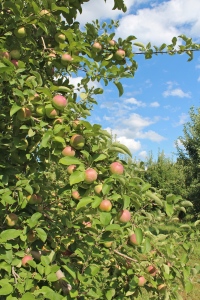 Almost as rare as the Russian apples are Lodi, a tart, yellow-green apple with soft flesh, developed from a cross of Montgomery and Yellow Transparent in New York state in 1924, and Quinte, a Canadian apple from 1964 resulting from a Red Melba-Crimson Beauty cross. Quinte is mostly red, firmer than Lodi, with a nicely balanced flavor.
Almost as rare as the Russian apples are Lodi, a tart, yellow-green apple with soft flesh, developed from a cross of Montgomery and Yellow Transparent in New York state in 1924, and Quinte, a Canadian apple from 1964 resulting from a Red Melba-Crimson Beauty cross. Quinte is mostly red, firmer than Lodi, with a nicely balanced flavor.
Brookfield Orchards in North Brookfield, Massachusetts, has a small supply of both apples, and Diana Nydam, a member of the fifth generation of the farm started by Arthur Lincoln in 1918, saved a few of each for us to sample and photograph. Brookfield Orchards, too, was spared from hail and is looking at a better-than-average crop.
Two of the next apples to arrive on the scene, Jersey Mac and PaulaRed, are more widely available and keep better than the other varieties in this early season group. Despite its name, Jersey Mac does not have McIntosh heritage; its parentage includes Melba, Wealthy, Starr, and Red Rome.
Like Vista Bella, Jersey Mac was developed at Rutgers University in 1956, and released commercially in 1971. Jersey Mac has a mild, sweet flavor, with hints of strawberry. While it does not store well compared to later apples, it lasts longer than the first apples to appear, especially if kept cold.
PaulaRed is of similar vintage as Jersey Mac, discovered in Michigan in 1960 and released commercially in 1968. It is a chance seedling discovered near an orchard of McIntosh trees, and its sweet-tart flavor and red color with green highlights suggest that its parentage may include McIntosh.
The real Macs are just a few short weeks away.
*
IN BETWEEN visits to Carlson and Brookfield Orchards, we made a brief stop at J. P. Sullivan and Co. in Ayer, the biggest apple packing and shipping facility in New England. Big things are happening at J. P. Sullivan this summer, including a major solar installation and a brand new packing line that is scheduled to go online August 20.
This once-in-a-generation investment speaks volumes about the company’s confidence in the apple industry, and will give apples an even smoother, safer ride as they are cleaned, sorted, and packed for shipping to the region’s grocery stores.
*
If you are considering orchard hopping this weekend, here are two events of note:
THE OPENING RECEPTION for the third Art In The Orchard, a biennial outdoor sculptural exhibit at Park Hill Orchard in Easthampton, Massachusetts, is this Saturday, August 15, from 1 p.m. to 5 p.m. This walking orchard tour features the works of more than 20 artists from around the region, whose sculptures are nestled in and among the apple trees. The sculptures will remain on view through October 15.
Carlson Orchards celebrates its 13th Annual Peach Festival Saturday, August 15, and Sunday, August 16, from 10 a.m. to 4 p.m., rain or shine. There will be live music, hay rides to the peach orchards, product sampling, and a cookout. For more information, call 978-456-3916.
*
WORKING ORCHARD MANAGER: Seeking a passionate, hardworking manager and farmer for a family owned and operated fruit orchard in central Connecticut that has been in business for more than 38 years. We grow apples, pears, peaches, nectarines, and plums for pick-your-own and wholesale on 33 acres with a country store, which is managed separately.
The position will lead and oversee the property, farming, and management of staff, as well as hands-on work that includes, but is not limited to, pruning, fertilizing, spraying, herbiciding, harvesting, grading, and running wholesale and pick-your-own business.
Experience in fruit growing is preferred but not necessary. On-site training from the owner of the orchard will be a large part of the on-boarding process to help you learn the details of the property and business. The owner will be your partner in management to ensure success, as we see this as a long-term career opportunity for you.
Thank you for your interest. Please call 203-213-8833 to learn more about this new position.
*
TWO RECENT BOOKS by Russell Steven Powell, senior writer, and Bar Lois Weeks, executive director of the New England Apple Association, explore the history of apple growing in the region and look at the nation’s apple industry.
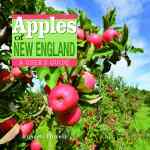 Apples of New England (Countryman Press) is an indispensable resource for anyone searching for apples in New England orchards, farm stands, or grocery stores — or trying to identify an apple tree in their own backyard.
Apples of New England (Countryman Press) is an indispensable resource for anyone searching for apples in New England orchards, farm stands, or grocery stores — or trying to identify an apple tree in their own backyard.
The book contains color photographs by Weeks and descriptions of more than 200 apples discovered, grown, or sold in New England, accompanied by notes about flavor and texture, history, ripening time, storage quality, and best use. Apples of New England offers practical advice about rare heirlooms and newly discovered apples.
Apples of New England includes chapters on the rich tradition of apple growing in New England, and on the “fathers” of American apples, Massachusetts natives John Chapman (“Johnny Appleseed”) and Henry David Thoreau. Apples of New England presents the apple in all its splendor: as a biological wonder, as a super food, as a work of art, and as a cultural icon.
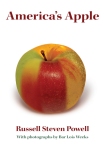 America’s Apple (Brook Hollow Press) tells a rich and detailed story about apple growing in America, from horticulture to history to culinary uses. Powell writes about the best ways to eat, drink, and cook with apples. He describes the orchard’s beauty and introduces readers to some of the family farms where apples are grown today, many of them spanning generations.
America’s Apple (Brook Hollow Press) tells a rich and detailed story about apple growing in America, from horticulture to history to culinary uses. Powell writes about the best ways to eat, drink, and cook with apples. He describes the orchard’s beauty and introduces readers to some of the family farms where apples are grown today, many of them spanning generations.
America’s Apple looks at how America’s orchards are changing as a result of the trend toward intensive planting and the trademarking of new varieties, and what that means to consumers. Powell also writes about the fragile underpinnings of modern agriculture: the honeybees needed to pollinate the crop and the labor required to pick it, plus new and exotic pests and increasingly volatile weather.
Apples of New England and America’s Apple are available in hardcover at fine bookstores and orchards and online. America’s Apple is also available in paperback.
For more information, write to newenglandapples@verizon.net.
*
WITH THE 2015 pick-your-own season upon us, now is a good time to review our four-minute video about how to prepare for your orchard visit:
Happy picking!

